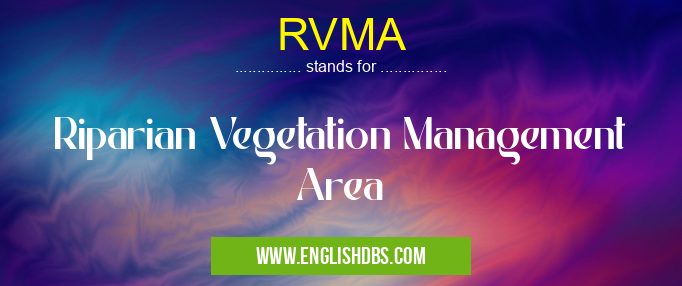What does RVMA mean in MANAGEMENT
RVMA stands for Riparian Vegetation Management Area. It refers to designated areas along the banks of rivers, streams, lakes, and other water bodies where vegetation is managed to protect water quality, aquatic habitat, and riparian ecosystems.

RVMA meaning in Management in Business
RVMA mostly used in an acronym Management in Category Business that means Riparian Vegetation Management Area
Shorthand: RVMA,
Full Form: Riparian Vegetation Management Area
For more information of "Riparian Vegetation Management Area", see the section below.
» Business » Management
Significance of RVMAs
- Water Quality Protection: Vegetation along water bodies helps filter pollutants, reduce erosion, and protect against sedimentation.
- Aquatic Habitat Enhancement: Riparian vegetation provides shelter, food, and breeding grounds for aquatic organisms.
- Riparian Ecosystem Support: RVMAs support a diverse range of plant and animal species, contributing to biodiversity and ecosystem stability.
- Flood Control: Vegetation in RVMAs can help slow down floodwaters and reduce erosion, mitigating flood risks.
- Recreation and Aesthetics: RVMAs often provide opportunities for recreation, such as fishing, hiking, and wildlife viewing, while also enhancing the aesthetic value of water bodies.
Management Practices in RVMAs
Management practices in RVMAs aim to balance the need for vegetation protection with other land uses. Common practices include:
- Selective Vegetation Removal: Removing invasive species or vegetation that poses a threat to water quality or aquatic habitat.
- Prescribed Burning: Controlled burns can reduce fuel buildup and promote the growth of native vegetation.
- Grazing and Haying: Limited grazing or haying can help maintain vegetation health and reduce fire risk.
- Buffer Strips: Establishing buffer strips of undisturbed vegetation along water bodies to protect against pollutants and erosion.
Essential Questions and Answers on Riparian Vegetation Management Area in "BUSINESS»MANAGEMENT"
What is an RVMA?
A Riparian Vegetation Management Area (RVMA) is a designated area alongside rivers, streams, and other water bodies where vegetation is managed to protect and enhance the riparian ecosystem. It typically includes a buffer zone of natural vegetation that helps filter pollutants, stabilize banks, provide wildlife habitat, and maintain water quality.
Why are RVMAs important?
RVMAs play a crucial role in maintaining the health of aquatic ecosystems. They provide shade and regulate water temperature, which is essential for fish and other aquatic organisms. The vegetation also acts as a natural filter, removing sediment and nutrients from surface runoff before it enters the water body. Additionally, RVMAs provide important habitat for a variety of wildlife species.
How are RVMAs managed?
RVMA management typically involves selective removal of invasive or non-native species, thinning of dense vegetation, and planting of native species. The specific management techniques used will vary depending on the local conditions and objectives. However, the overall goal is to maintain a healthy and diverse riparian ecosystem.
What are the benefits of RVMAs?
RVMAs provide numerous benefits, including:
- Improved water quality
- Reduced erosion and sedimentation
- Increased wildlife habitat
- Enhanced aesthetic value
- Flood control
- Carbon sequestration
Who is responsible for managing RVMAs?
The responsibility for managing RVMAs may vary depending on the jurisdiction. In some cases, local governments or conservation organizations may be responsible for their management, while in other cases, private landowners may be responsible for maintaining the vegetation within their property's RVMA.
Final Words: RVMAs are crucial for maintaining the health and integrity of water bodies and their surrounding ecosystems. By implementing appropriate management practices, we can ensure that riparian vegetation continues to provide vital benefits for water quality, aquatic habitat, and overall ecosystem health.
